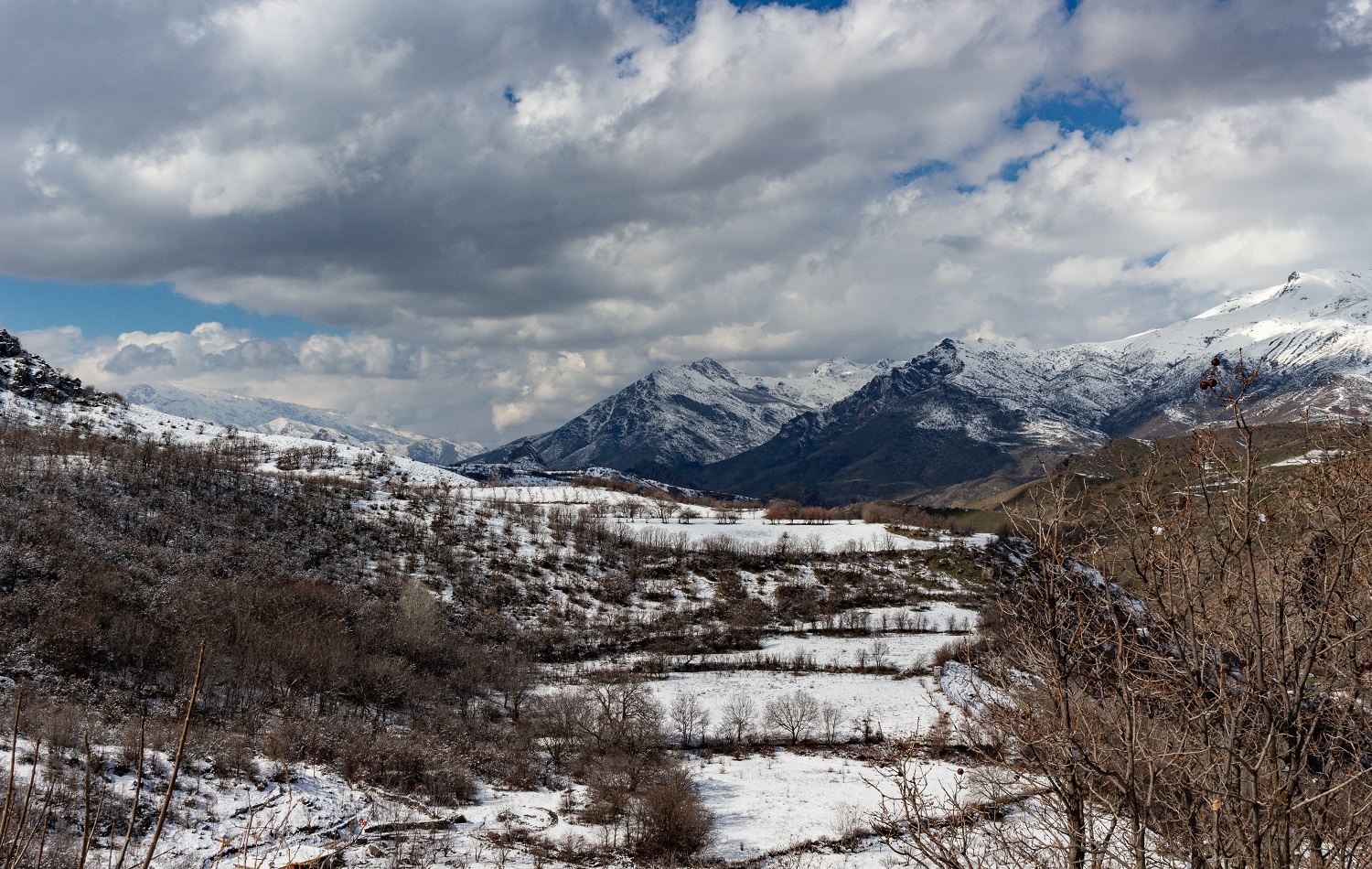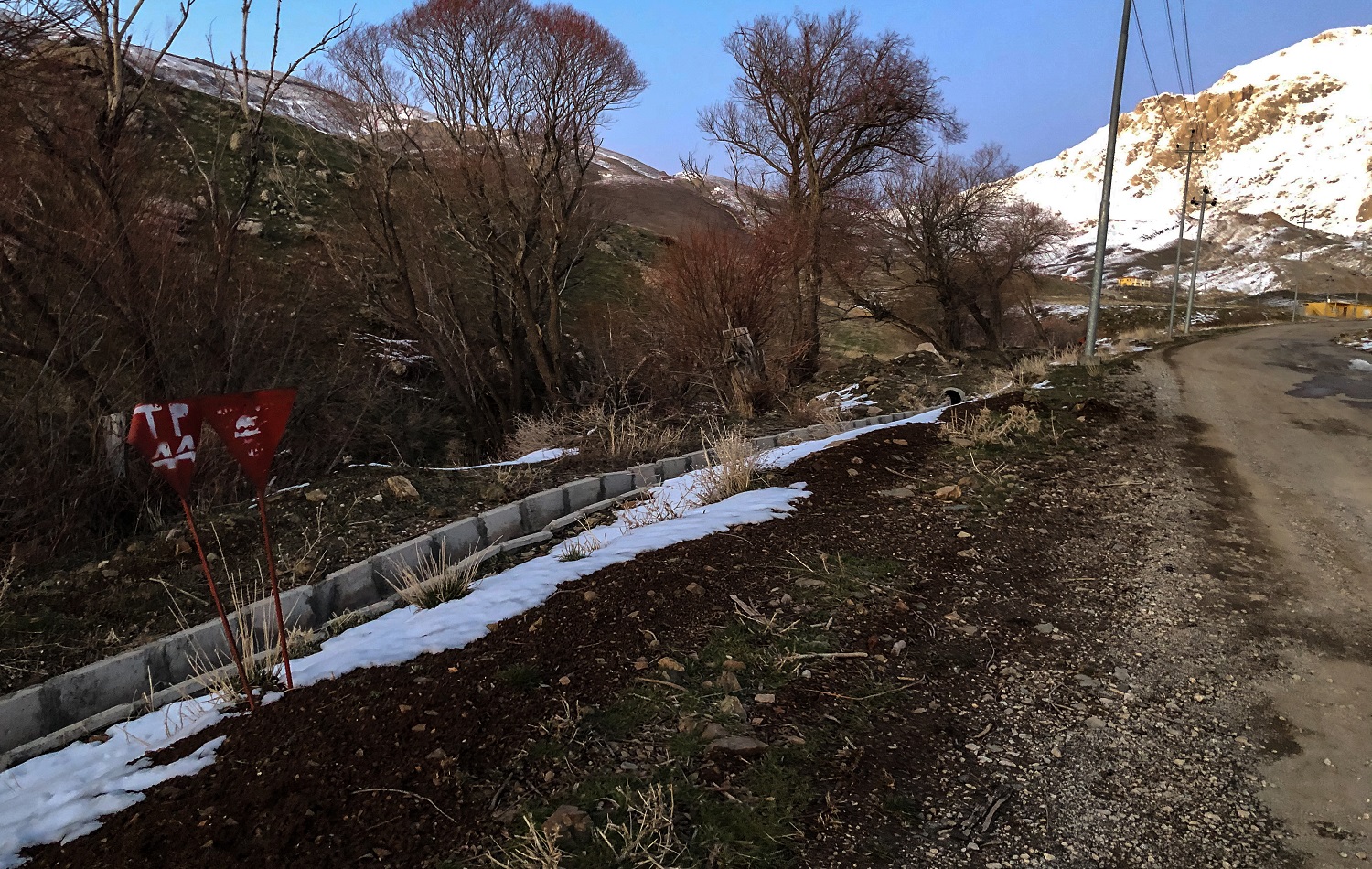HALGURD-SAKRAN NATIONAL PARK, Kurdistan Region — Crystal clear, ice cold water rushes through a narrow gorge, tumbling over rocks and under a rickety bridge. Cliffs tower overhead, the rock face of one side leaning in towards its sibling across the stream. This is the Valley of Two Brothers in Halgurd-Sakran National Park. According to local legend, the two cliffs were once so close to each other that people could reach out and pass things across the chasm.
On a sparkling sunny day in February, the sound of the water and the occasional song of a bird are hushed under a shroud of newly-fallen snow. But don’t let the tranquility fool you.
“We are in conflict,” said park manager Bakhtyar Bahjat.
Halgurd-Sakran National Park was the dream of one man who used his charm, will-power, and connections to make it a reality. But he died before all of the paperwork was done and, without his driving force, the park is floundering, victim to a governance system of personalities rather than institutions, where party loyalty is valued over expertise. Egos and interests vie for control while the environment hangs in the balance, as does the well-being of those who want to protect it.
It is a park in two halves that cradle the town of Choman in eastern Erbil province, along the border with Iran. The northern half is dominated by Mount Halgurd, the tallest in Iraq at 3,607 metres, and the southern half, Sakran, is bordered by the Qandil Mountains.
Fellaw Pond is a popular spot, attracting visitors to its clear waters and stunning vistas. But some people came with off-road vehicles, tearing up the ground with their 4x4s. To stop this, two years ago the authorities dug a trench between the road and the pond. Soon afterwards, Salar Chomany, a local mountain guide, was visiting Fellaw where he saw a group of off-road drivers who had somehow managed to cross the trench and were circling the pond.
“I went up to them and asked how they did this,” Chomany recalled. The men ignored him, but a fight broke out between the drivers and residents of a nearby village who were unhappy with the heavy cars destroying the delicate plant life. Chomany said he was not involved in the brawl, yet one of the drivers filed a lawsuit against him.
The court case was resolved with the charges dropped, but Chomany said the drivers and their relatives, who are from the Choman area, continued to threaten him. He moved away for a while, going to work in Duhok.
On the evening of February 1 this year, Chomany was walking with his wife in Choman’s market when he says he was confronted by a group of the off-road drivers. He said one beat him over the head with a stick, knocking him unconscious. On the ground, the men reportedly continued to hit and kick him while his wife screamed for help. Chomany woke up a few hours later in hospital.
The alleged attackers are now out on bail, awaiting trial, while Chomany and his wife live in fear. He says he is exposed because he has no influential friends or political allegiances to protect him.
“I’m an environmentalist. I’m a mountaineer. I encourage people to protect the environment. I’m an activist. I have many times called on local authorities to support campaigns to protect the environment. But without party membership, I have no backing,” he said.
Halgurd-Sakran park was the brainchild of Abdulwahid Gwani, former mayor of Choman, who in 2010 brought in experts from Austria to start carving a national park out of the land surrounding his hometown. He secured a funding pledge of $12 million from the government, built a visitor centre, and hired park rangers.
He championed a 2011 regulation from the Council of Ministers that dictated the establishment of a committee made up of representatives from the ministries of agriculture, finance, and interior, the environment board, and environmental experts who would manage the park.
But work ground to a halt in 2014, when a trifecta of world events drew attention and resources away from the park. The Islamic State group (ISIS) swept across parts of Syria and Iraq, and threatened the borders of the Kurdistan Region. Kurdish forces, including the park rangers and mine clearers, were diverted to the war effort. Then, the government’s revenues plummeted because of low oil prices and disputes with Baghdad. And in 2015, peace talks between the Kurdistan Workers’ Party (PKK) and the Turkish government collapsed, so Turkish warplanes and drones reappeared in the Kurdistan Region’s skies over the PKK’s Qandil headquarters.
ISIS has been territorially defeated, but the Kurdistan Region is still struggling to find secure financial footing, and the PKK-Turkey conflict continues to rage. In 2017, Gwani passed away, and his dream of a national park is now in limbo. The committee was never established and the park has no funds.
“It was an individual initiative,” explained Abdulrahman Sidiq, head of the Kurdistan Region’s environment board, about the Council of Ministers’ regulation to formalize the park. There are no problems or obstacles in the way of establishing the committee, but since Gwani’s death, “no one followed up on it,” he said.
Sidiq’s environment board is underfunded, and, as a board, lacks the power that a ministry would have. He said he has asked the government to set up the committee, but “This official request has gone unanswered.”
This is typical of governance and decision-making in the Kurdistan Region where most power lies outside of formal structures, according to Kamaran Palani, a lecturer at Erbil’s Salahaddin University and research fellow at the Middle East Research Institute (MERI).
“Oftentimes individuals fail to transform and translate their power and agency into the rules and institutions, so they can ensure sustainability and continuity,” he explained. When new people take over posts, they often ignore the work of their predecessors and their actions “won’t be guided by rules and organizations, in other words, institutions.”
Within institutions and ministries, rules can be circumvented and doors opened through a phone call, payment of a fee, or personal connections known as wasta. If the official answer to a request is no, a phone call to a shadowy figure at a ministry can remove the block, for a price.
“The first major step towards institutionalisation, that is to say ‘state-building,’ is to transform and translate the power and ability of powerful actors and individuals into the units, rules, organisations and institutions,” said Palani.
It’s a problem for the environment across the Kurdistan Region, not just in the park. “It is very difficult to say the KRG [Kurdistan Regional Government] has been supportive” of environmental efforts, wildlife conservation expert Hana Raza said in a talk in January. “It’s more so individuals within the KRG are supportive,” she added, explaining that you may build up a good rapport with one person, but when someone new is appointed to that post, collaboration has to start at the beginning again.
Environmental organizations are also often stopped at provincial borders where one political party’s influence ends and another begins. Raza, who is based in Sulaimani and works for Nature Iraq and the Persian Leopard Conservation group, said she has been refused permission for many projects in Erbil and Duhok provinces. “Frankly, the collaboration ends at the borders of Sulaimani-Erbil,” she said.
Nature is not bound by borders, but work on it is, making the environment collateral damage in party squabbles.
With no one at the helm, no formal management or funds, Halgurd-Sakran National Park is at the mercy of a multitude of factors from poachers to private landowners and preservation of its unique environment cannot be enforced.
Halgurd-Sakran not only boasts the highest mountain peak, but also the highest lake in Iraq - Bekodyan sits at around 3,200 meters above sea level. The park has four distinct seasons, acres of forest, and ample freshwater in its mountain streams. A recent survey of flora in the park by the Kurdistan Botanical Foundation found about 1,500 to 1,700 plant species, many endemic to the area and some new discoveries.
In 2010, the United Nations set a target that 17 percent of land should be within preservation areas by the year 2020. Just 48 out of 196 nations are meeting or exceeding that goal, and new research says we should nearly double that to 30 percent if we want to maintain a stable climate. At the One Planet Summit in January, 52 nations committed to reaching that higher target by 2030, hoping more will get on board ahead of the next meeting under the UN biodiversity convention, scheduled for October.
Iraq is dismally behind in its obligations. Just a fraction of Iraqi land, 1.53 percent, is designated as protected, and that label does not mean the land is safeguarded. For example, most of Iraq’s remaining woodlands are within the Kurdistan Region, but, “As with many of the country’s urban parks and nature reserves, they’re suffering from insufficient protection, planning and investment,” the United Nations wrote in a February report.
One of the biggest threats to Kurdistan’s forests is fire, sparked by errant picnickers or bombs. According to a 2020 report from the Dutch organization PAX, about 23,000 acres of land within protected environmental zones was burned in 2020, the fires directly linked to Turkish military campaigns against the PKK.
The PKK is a mixed blessing for Kurdistan’s nature. They attract Turkish bombs, but they also control a large area of the park and are “protectors of the environment,” said park manager Bahjat. Cutting down trees and hunting are forbidden in PKK-controlled territory and the guerrillas are much more effective at enforcing these rules than the Kurdistan Region’s forces.
Lake Bekodyan lies within PKK-controlled territory and has only recently begun attracting visitors. Bahjat said he and his friends have sometimes been approached by PKK fighters when they visit the lake, but the guerrillas don’t come around much anymore. The lake has gained popularity, largely driven by social media posts from Bahjat and other Choman locals. He now estimates 1,000 people visit the lake every summer and the PKK appears to be tolerating it.
Iranian Kurdish armed groups like the Kurdistan Democratic Party of Iran (KDPI) and Komala are also present in the mountains along the border with Iran, occasionally drawing Iranian fire.
Landmines decades old are another environmental “protector.” The area was a frontline in the Iran-Iraq war of the 1980s and munitions still litter the parkland. Every year, people are maimed or killed by mines. One of the first things Gwani did when he conceived the park was bring in teams to clear landmines and, while some areas are now safe for visitors, other areas are strictly no-go zones.
The road into the Sakran half of the park is winding and potholed. Nearing the Iran border, small, red triangular signs start appearing on the roadside and in the distance, up the mountains. Skulls on the signs are grim warnings of the deadly mines lying beneath the soil. There are so many mines on Mount Girdamand that it is still too dangerous to retrieve the bodies of soldiers killed decades ago.
The landmines are preventing development – a good thing in the eyes of Bahjat. Without the landmines, politicians and investors who want to profit from the park without regard to protecting the environment “would invade,” he said.
Bahjat is not paid for his work. He spends his own money on small things like putting up information signs in the park, and says he’s often told he’s “silly” for doing so.
With no staff, it is impossible to police activities in the park. Foragers, hunters, poachers, and tree-fellers have free rein. In one day, I saw freshly cut logs lying by the side of the road for collection, dump trucks carting loads of sand out of the park, a poacher carrying bird cages under his arms, and heard the shot of a hunter’s rifle. Plastic bottles and empty cigarette packets litter the mountainsides.
There is also no control over tourism development in the park, so individuals who own land do their own thing to make money. They rent out their houses, build new houses to rent out, and build picnic spots for day trippers. There is no plan, no strategy, no overall management.
The Kurdistan Region’s finances are in dire straits. The oil-dependent economy took a hit when crude prices plummeted last year during the coronavirus pandemic. Iraq, on the verge of bankruptcy, devalued the dinar. Deep-rooted disputes between Erbil and Baghdad over budgets and oil sales complicated the matter, and the federal government was not sending regular payments to the regional capital. The sum of it all was that Erbil was not able to pay its public sector workers on time or in full.
Choman felt the crunch, hard. The government is the largest employer here – home to many Peshmerga and border workers. An alternative source of income would be a boon for the area and the park could be the answer. But with no park management, no plan, no strategy, development is ad hoc, unregulated, and, in many cases, harmful.
There are more than 50 villages within the park boundaries, and 60 percent of the land is privately owned. In winter, many of the houses sit empty and resorts are boarded up against the cold, waiting for the busy summer season. Last summer, business was bad.
“Our business went down to zero last year because of corona. It was very bad,” said Ali Rasool, owner of Ene Resort.
He built his resort in 2017, borrowing money with the hope of tapping into a growing tourism trade. He still has not been able to repay the loan.
The global pandemic is not Rasool’s only problem. “We need good roads,” he said. “The government has not extended services to our area.”
Rasool built the road to his resort himself and set up all his own electricity – hooking into the national grid that provides power for about 12 hours a day, roughly from 4 pm to 4 am. Dozens of villages in the Halgurd-Sakran area used to have hydropower, generating electricity from the numerous rivers and streams. But around 2003, they began connecting up to the national grid, taking a backward step in terms of reliable electricity supply and clean energy.
To make his business a viable one, Rasool says he needs government investment – good roads, steady electricity supply, and development of tourism services. Right now there are no restaurants in the park, and accommodation is limited to renting out private homes. Resorts like Rasool’s cater to day visitors.
Without the government’s regulation on management of the park implemented, individual, unregulated efforts like Rasool’s are the only ones trying to develop the park as a tourist destination.
“The park has stopped for seven or eight years, because there is no law or regulation in place,” said Choman mayor Swara Ahmdi.
Ahmdi heads a local board to run the affairs of Halgurd-Sakran, a temporary measure that he says is working to “safeguard the national park.”
Coordinating with private landowners is the biggest problem his committee faces. Ahmdi said they have ordered locals not to build houses without the committee’s permission, and have banned tree cutting and sand mining. But, “We cannot forcibly stop people from building a house.” If the landowners turn to the law, “the law will support them because there are no regulations in place,” he said.
“The people are the rightful owners of this land.”
The committee is also focusing on looking for investors, foreign and local, to develop and build tourism infrastructure. But most people are scared away by the challenge of working in an area where basic services are lacking, the PKK is partly in control making it an active conflict zone, and the border with Iran is so close.
“Many investors have been discouraged by the atmosphere,” said Ahmdi.
Exactly how to build up the tourism industry is a matter of debate. Bahjar is worried that names that have been bandied about to manage the park have no experience in park management or understanding of environmental issues. He fears the national park will be lost.
“We know that, if we let them, we will just have a name. Nothing else. Because they know nothing about what a national park is. They think it’s just a tourism project,” he said. “The national park is meant to protect the area and its nature.”




